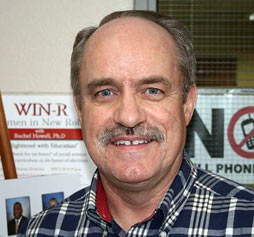By Susan Tallant/editor-in-chief
When students enter the office of most U.S. campus presidents, they find a married, graying white man, at least 50 years old with a doctoral degree.
According to a study of college presidents by the American Council on Education released earlier this year, the rate of diversification has been particularly slow since the late 1990s.
But not so for TCC, with only one president fitting that mold.
“I guess I do fit that ‘average presidential mold,’” Dr. Larry Darlage, NE Campus president, said. “My perception is that the stereotypical college president is changing, and it should.”
Darlage said each year when he attends national conferences with other college presidents, he notices a change.
“ Five or 10 years from now after many of us silver-haired, white male presidents have retired, there will be a lot more diversity among the presidential group that will be more reflective of the student population,” he said. “I think these changes are needed and are positive.”
One way Darlage is unique among college presidents is he also works “out in the field.”
“ I still teach a chemistry course every other year,” he said.
And it’s a practice he plans to keep up.
“[Teaching] keeps me up to date professionally and helps me maintain close contact with students and faculty.”
Chancellor Leonardo de la Garza said diversity at TCC is the result of conscious decisions as well as happenstance.
“I can only personally speak to the 10 years, going on 11, that I’ve been privileged to serve as chancellor,” he said.
De la Garza said appointments made to the Chancellor’s Executive Leadership Team (which now includes five campus presidents) have been conscious and deliberate.
“I want to ensure I bring onto the team the very best and most qualified, experienced and credentialed professional to each position,” he said.
De la Garza believes the diversity to be a “very good thing” and said it reflects the demographic makeup of the community and student body.
TCC’s five campus presidents represent a rich diversity with three women and two men: Dr. Judith Carrier; Dr. Elva LeBlanc and Dr. Tahita Fulkerson (two Anglos and one Hispanic); Dr. Ernest Thomas (African-American) and Darlage (Anglo).
“I believe the TCC Chancellor’s Executive Leadership Team probably is among the most—if not the most—diverse and professionally qualified you will find at any college or university in Texas,” de la Garza said.
Carrier, president of SE Campus and first female president hired at TCC, said the traditional face of leadership is indeed changing, but more readily in community colleges.
“Diversity is becoming more evident in state and national meetings where CEOs and chief academic officers are present,” she said.
Carrier said it is important that our students see themselves in our district and campus leadership.
“Only if they see representatives of their gender, ethnicity and race will they see a future for themselves,” she said.
Fulkerson, president of the Downtown Campus, watched Carrier work hard to serve students, to develop campus traditions and to reach out to the community.
Fulkerson has a great respect for her male colleagues and the work they do but believes a female president is logical for TCC.
“Our population of students is predominantly female, and that number is rising,” she said. “Of course, in presidents of both genders, females find role models for leadership and service, but perhaps our female students can relate more easily to females in that role.”
“And many female administrators at TCCD are exemplary professional women who make enormous contributions to major work at the college,” she said.
Fulkerson also worked with Dr. Elva LeBlanc, NW Campus president, in 1993 when LeBlanc was dean of instruction and Fulkerson was humanities division chair on NW Campus.
“Dr. LeBlanc affirmed the value of clarity of expression, incisive decision making and a happy spirit,” she said. “She has those same qualities today.”
Thomas, South Campus president, said the American Council on Education’s study of the typical campus president is fairly accurate and reflects the history of past hiring practices in higher education, particularly in four-year colleges and universities.
“However, in my experience, there tends to be a little more diversity in the leadership of community colleges,” he said.
Thomas said the presence and participation of different world-views actively engaging in the decision making-process of the college expands the dimension of possible resolutions to issues.
“Until the rich diversity of the human family is fully accepted and embraced, our lives will continue to be guided by myopic ethnocentrism,” he said.





























